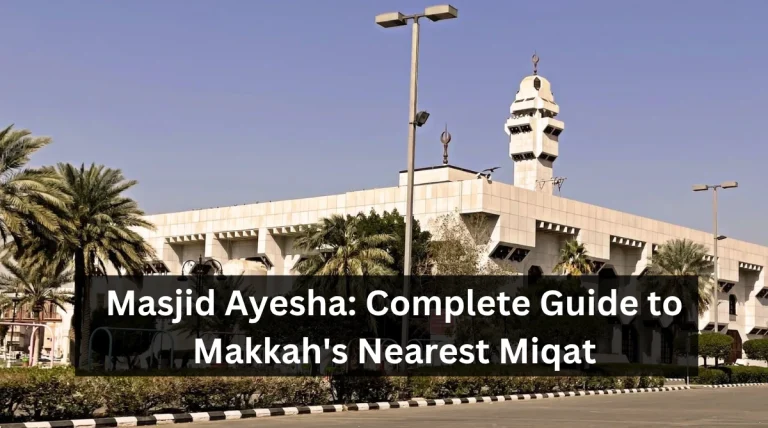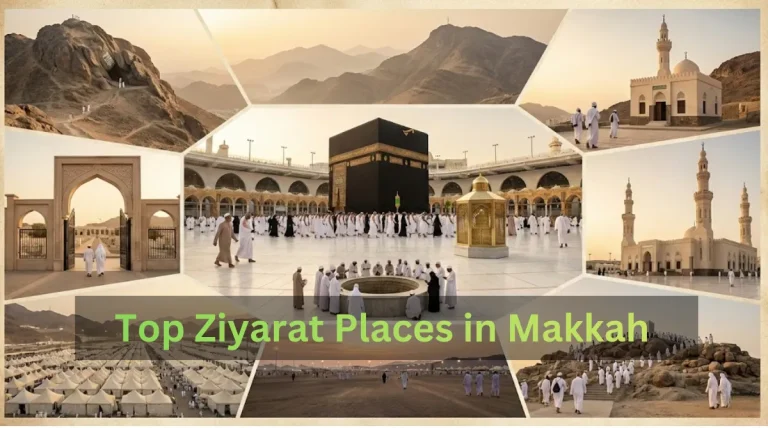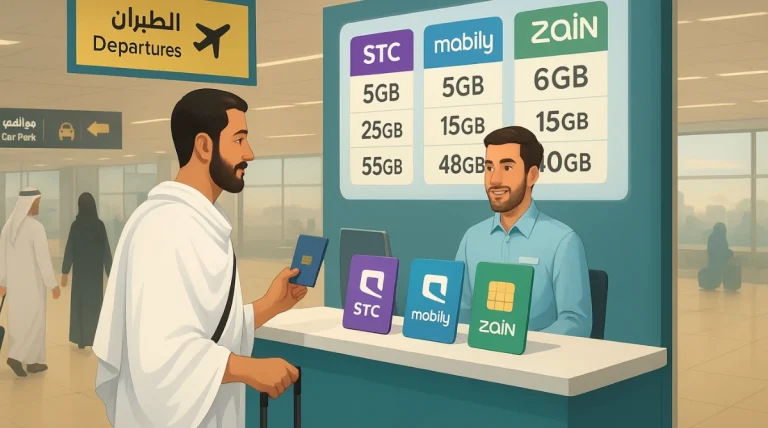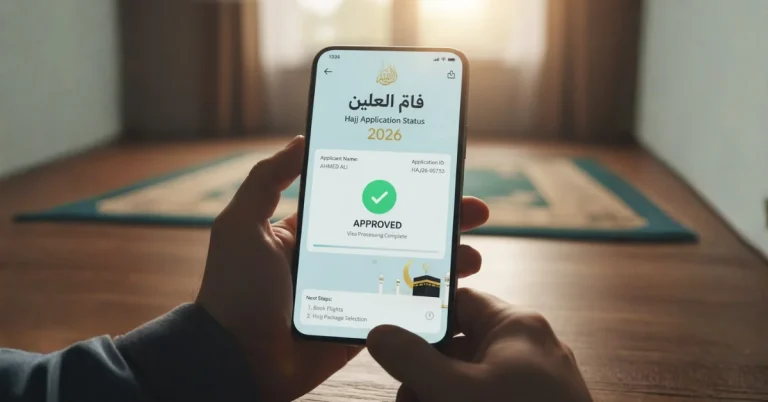How to Perform Umrah/Umrah Ka Tarika: Complete Step By Step Guide
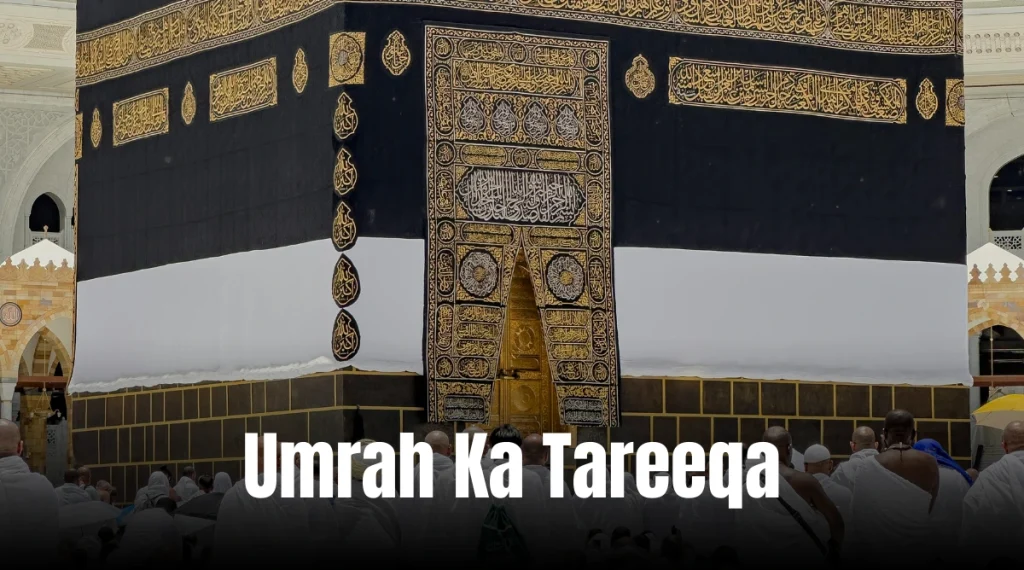
For Muslims, the moment you first see the Holy Kaaba represents the culmination of years of prayers and dreams. The Prophet Muhammad (ﷺ) said: العُمْرَةُ إِلَى العُمْرَةِ كَفَّارَةٌ لِمَا بَيْنَهُمَا “One Umrah to another expiates whatever sins occurred between them.” (Sahih al-Bukhari 1773)
This comprehensive pilgrimage guide provides travelers with authentic Islamic guidance and practical steps for How to Perform Umrah, from visa requirements to completing the sacred rituals in Makkah
The average cost of performing Umrah in Pakistani currency depends on various factors such as duration of stay, type of accommodation chosen, mode of transportation etc., but typically ranges from PKR 180-250 thousand per person (including airfare).
Quick Overview: The 4 Steps of Umrah
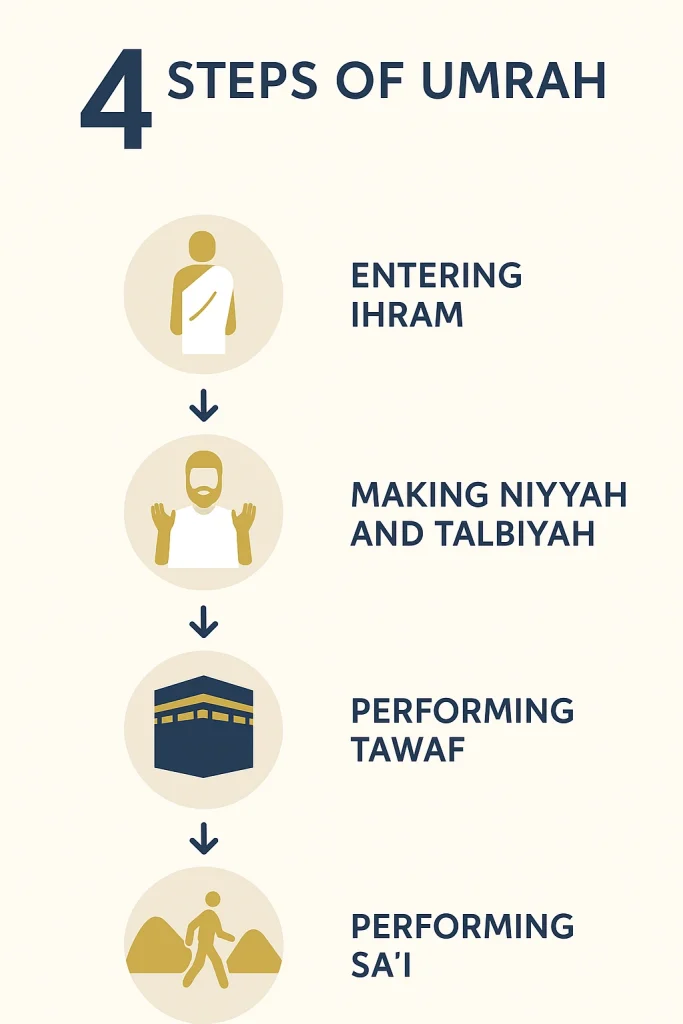
Umrah consists of four main rituals performed in sequence:
- Ihram – Enter the sacred state before crossing Miqat
- Tawaf – Circle the Holy Kaaba seven times
- Sa’i – Walk between Safa and Marwa seven times
- Halq/Taqsir – Cut hair to exit Ihram
The complete process takes 3-6 hours depending on crowds. The Prophet (ﷺ) said: عُمْرَةٌ فِي رَمَضَانَ تَعْدِلُ حَجَّةً “An Umrah in Ramadan equals a Hajj.” (Sahih al-Bukhari 1764)
Umrah vs Hajj: While Hajj is obligatory once in a lifetime and performed during specific dates, Umrah is voluntary and can be done year-round, making it more accessible for Pakistani families.
Pre-Departure Preparation for Pakistani Pilgrims
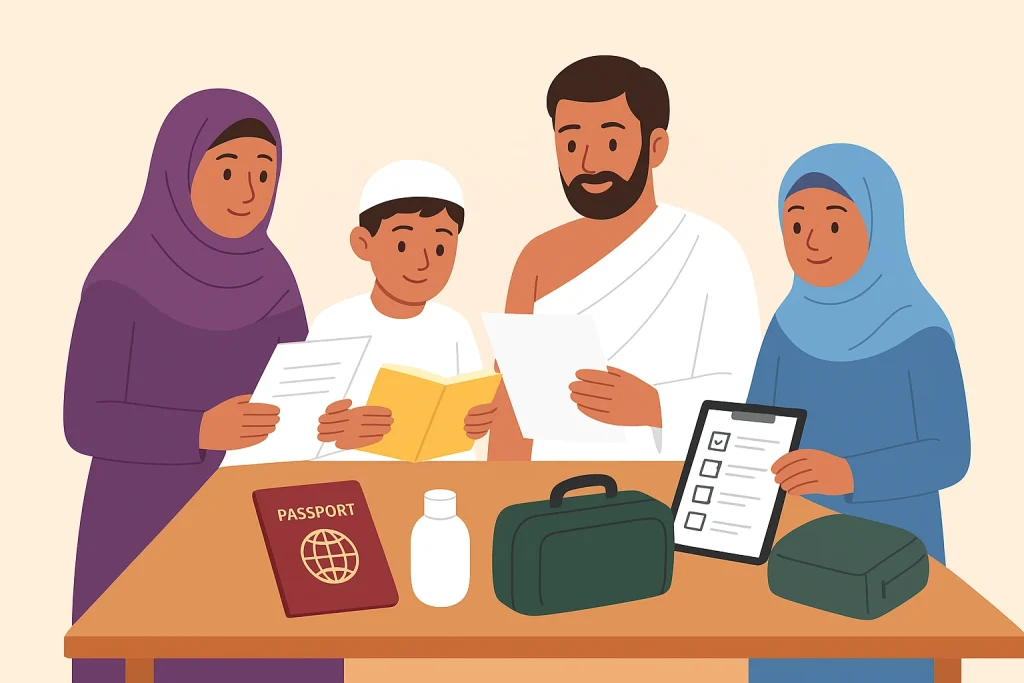
Essential Documents
For Pakistani Citizens:
- Valid passport (6+ months validity)
- Umrah visa (processed through authorized agents)
- Vaccination certificates (Meningitis, COVID-19)
- Marriage certificate (for couples)
- Mahram relationship proof (for women under 45)
KSA Travels assists Pakistani pilgrims with complete visa processing and documentation support from all Over Pakistan.
Physical and Spiritual Preparation
The Prophet (ﷺ) taught: إِذَا أَرَادَ أَحَدُكُمْ أَنْ يُحْرِمَ فَلْيَغْتَسِلْ “When one of you wants to enter Ihram, let him take a bath.” (At-Tirmidhi 830)
Before Travel:
- Walk 4-5km daily to build endurance
- Learn essential Arabic du’as with meanings
- Settle debts and seek forgiveness from others
- Pack unscented toiletries for Ihram
Estimated Costs for Pakistani Pilgrims:
Additional expenses: PKR 50,000-100,000
Step 1: Entering the State of Ihram
The state of Ihram represents the spiritual gateway between ordinary life and the sacred realm surrounding Allah’s House. For Pakistani pilgrims traveling to perform this blessed pilgrimage, understanding when and how to enter Ihram is crucial for a valid Umrah.
Sacred Boundaries (Miqat) for Pakistani Travelers
Allah has established specific geographical boundaries called Miqat around Makkah, beyond which no pilgrim may pass without entering Ihram. Pakistani travelers typically encounter these boundaries based on their flight routes and travel plans.
Primary Miqat Points Affecting Pakistani Pilgrims:
Dhul Hulayfah: Located 450 kilometers from Makkah, this serves Pakistani pilgrims traveling from Madinah to Makkah. Many Umrah packages from Pakistan include Madinah visits, making this a relevant Miqat point.
Yalamlam: Positioned 120 kilometers from Makkah, this boundary affects Pakistani pilgrims flying certain routes or approaching from the south.
Juhfah: Situated 190 kilometers from Makkah, this historical Miqat serves some Pakistani flight routes, particularly those coming from Egypt or Syria.
For Pakistani Air Travelers: Most Pakistani pilgrims flying directly from Lahore, Karachi, or Islamabad to Jeddah will cross the aerial Miqat during their flight. Airlines typically announce this boundary crossing, but Pakistani travelers should prepare by entering Ihram before or during the flight, well before the announcement.
Ihram Requirements for Pakistani Pilgrims
Men’s Ihram: Pakistani men must wear two pieces of white, seamless cloth. The lower garment (Izar) wraps around the waist covering from navel to ankles, while the upper garment (Rida) drapes over the left shoulder. Many Pakistani Islamic stores sell proper Ihram sets with appropriate measurements for subcontinental body types.
Women’s Requirements: Pakistani women may wear their regular shalwar kameez or abaya, ensuring loose fit and complete coverage except face and hands. The clothing color is flexible – white is not mandatory for women as it is for men.
Pre-Ihram Purification: Following the Sunnah, complete ghusl (full bath) before wearing Ihram garments. Pilgrims should trim nails, remove unwanted body hair, and men may apply non-alcoholic attar to head and beard (avoiding Ihram cloth). These preparations should be completed in Pakistan or at the departure airport.
Ihram Restrictions During Pilgrimage
Once Pakistani pilgrims enter Ihram, numerous restrictions apply that focus attention on spiritual rather than worldly concerns. The Quran emphasizes: فَمَن فَرَضَ فِيهِنَّ الْحَجَّ فَلَا رَفَثَ وَلَا فُسُوقَ وَلَا جِدَالَ فِي الْحَجِّ “So whoever has made Hajj obligatory upon himself therein, there is to be for him no sexual relations and no wickedness and no quarreling during Hajj.” (Al-Baqarah 2:197)
Physical Prohibitions: Pilgrims in Ihram cannot cut hair or nails, use scented products (including popular Pakistani perfumes and oils), cover the head (men) or face (women), wear stitched clothing (men), or hunt animals.
Behavioral Restrictions: Maintain exemplary Islamic conduct by avoiding arguments, marital relations, foul language, and sinful behavior. These restrictions help pilgrims focus entirely on their spiritual journey and connection with Allah.
Step 2: Making Niyyah and Reciting Talbiyah
The power of sincere intention (Niyyah) forms the foundation of all Islamic worship. The Prophet (ﷺ) taught: إِنَّمَا الْأَعْمَالُ بِالنِّيَّاتِ، وَإِنَّمَا لِكُلِّ امْرِئٍ مَا نَوَى “Actions are but by intention and every man shall have but that which he intended.” (Sahih al-Bukhari 1)
Making Your Umrah Intention
Pilgrims should make their Niyyah at or approaching the Miqat boundary. The intention represents your sincere commitment to Allah for performing this sacred pilgrimage journey from Pakistan to the Holy Cities.
Recommended Arabic Intention:
لَبَّيْكَ اللَّهُمَّ عُمْرَةً “O Allah, here I am to perform Umrah.”
Alternative Comprehensive Intention:
اللَّهُمَّ إِنِّي أُرِيدُ الْعُمْرَةَ فَيَسِّرْهَا لِي وَتَقَبَّلْهَا مِنِّي “O Allah, I intend to perform Umrah, so make it easy for me and accept it from me.”
Pakistani pilgrims may also make this intention in Urdu if Arabic is difficult: “Ya Allah, main Umrah karna chahta hun, ise mere liye aasan kar aur qabool farma.”
The Sacred Talbiyah
After making Niyyah, pilgrims must recite the Talbiyah to validate entry into Ihram. This ancient call connects you with millions of pilgrims throughout Islamic history who have made this same spiritual journey to Makkah.
The Complete Talbiyah:
لَبَّيْكَ اللهُمَّ لَبَّيْكَ، لَبَّيْكَ لَا شَرِيكَ لَكَ لَبَّيْكَ، إِنَّ الْحَمْدَ وَالنِّعْمَةَ لَكَ وَالْمُلْكَ، لَا شَرِيكَ لَكَ
“Here I am, O Allah, here I am. Here I am, You have no partner, here I am. Indeed, all praise, favor and sovereignty belong to You. You have no partner.”
Pronunciation Guide for Pakistani Pilgrims: “Lab-bayka Allahumma lab-bayk, lab-bayka la shareeka laka lab-bayk, inna al-hamda wan-ni’mata laka wal-mulk, la shareeka lak.”
Continuing the Talbiyah Journey
Ibn Umar (may Allah be pleased with him) narrated that this was the exact Talbiyah of Allah’s Messenger (ﷺ). Pilgrims should recite it frequently during their journey to Makkah, stopping only when beginning Tawaf around the Holy Kaaba.
Spiritual Benefits: Each recitation of the Talbiyah by pilgrims represents a renewal of commitment to Allah and rejection of worldly distractions. This sacred call transforms your travel from Pakistan into a spiritual ascension toward the Divine presence.
After reciting Talbiyah, send prayers upon Prophet Muhammad (ﷺ) and make personal supplications for yourself, your family in Pakistan, and the global Muslim community. Continue this practice throughout your journey until you reach the Sacred Mosque in Makkah.
Step 3: Arrival in Makkah and Sacred Mosque Entry
The Sacred Sanctuary (Haram) of Makkah
The Haram extends several miles around Masjid al-Haram, creating a sanctuary where Allah has established special rules. Pilgrims entering this blessed area must observe additional regulations that preserve the sanctity of this holy territory.
Within the Haram boundaries, Islamic law prohibits cutting any vegetation, harming wild animals (including the pigeons that visitors often see around the mosque), carrying weapons, and engaging in any behavior that violates the sacred atmosphere.
Recommended Du’a Upon Entering Makkah:
اللَّهُمَّ هَذَا حَرَمُكَ وَأَمْنُكَ فَحَرِّمْنِي عَلَى النَّارِ، وَأَمِنِّي مِنْ عَذَابِكَ يَوْمَ تَبْعَثُ عِبَادَكَ، وَاجْعَلْنِي مِنْ أَوْلِيَائِكَ وَأَهْلِ طَاعَتِكَ
“O Allah, this is Your sanctuary and security, so make me unlawful to hellfire, make me safe from Your punishment on the day You resurrect Your servants, and make me one of Your friends and people of Your obedience.”
Entering Masjid al-Haram
Pilgrims should follow the established Sunnah when entering the Sacred Mosque. While the preferred entrance is Bab al-Salam (Gate of Peace), modern crowd management may direct pilgrims to designated Umrah entrances.
Sunnah Method of Entry: Step through with your right foot first and recite the supplication for entering mosques:
بِسْمِ اللهِ، اللَّهُمَّ صَلِّ عَلَى مُحَمَّدٍ، اللّٰهُمَّ اغْفِرْ لِي وَافْتَحْ لِي أَبْوَابَ رَحْمَتِكَ
“In the name of Allah, send prayers upon Muhammad, O Allah, forgive me and open for me the doors of Your mercy.”
First Sight of the Holy Kaaba
For Muslims experiencing their first glimpse of the Holy Kaaba, this moment represents the culmination of years of dreams and prayers. Keep your gaze lowered until reaching the Tawaf area, then lift your eyes with complete humility to behold Allah’s House.
This blessed moment is among the times when du’as are readily answered. Pilgrims should raise their hands in supplication and make heartfelt requests for themselves, their families back in Pakistan, and the global Muslim community.
Essential Du’a Upon Seeing the Kaaba:
Recite three times: اللّٰهُ أَكْبَرُ، اللّٰهُ أَكْبَرُ، لَآ اِلَهَ اِلَّا اللّٰهُ
“Allah is the Greatest, Allah is the Greatest, there is no god except Allah.”
Comprehensive Supplication:
اللَّهُمَّ زِدْ هَذَا الْبَيْتَ تَشْرِيفاً وَتَعْظِيماً وَتَكْرِيماً وَمَهَابَةً، وَزِدْ مَنْ شَرَّفَهُ وَكَرَّمَهُ مِمَّنْ حَجَّهُ أَوْ اعْتَمَرَهُ تَشْرِيفاً وَتَكْرِيماً وَتَعْظِيماً وَبِرّاً
“Allah, increase this House in honor, esteem, respect and reverence. And increase those who honor and respect it—of those who perform Hajj or Umrah—in honor, respect, esteem and piety.”
Make abundant du’a for Pakistan’s Muslim community, your family’s guidance and protection, and your own spiritual development. This moment of first seeing the Kaaba creates memories that pilgrims treasure for life.
Step 4: Performing Tawaf al-Umrah
Tawaf represents the unity of believers in worshipping Allah, as pilgrims join millions from around the world moving in harmony around the House of Allah. This sacred circumambulation symbolizes the believer’s spiritual journey toward divine closeness.
Requirements for Valid Tawaf
Islamic jurisprudence establishes specific conditions for pilgrims to ensure their Tawaf meets religious requirements:
Essential Prerequisites: Personal performance (cannot be done by proxy unless physically unable), clear intention for Tawaf made sincerely for Allah, performance within Masjid al-Haram boundaries, state of ritual purity (wudu), proper covering of awrah, starting from Hajar al-Aswad corner, counter-clockwise movement, staying outside Hijr Ismail area, walking on foot if capable, completing exactly seven circuits, and performing two rak’ahs after Tawaf.
Preparation and Starting Point
Male pilgrims should perform Idtiba by uncovering the right shoulder, passing the upper Ihram garment under the right armpit and over the left shoulder. This Sunnah practice continues throughout all seven Tawaf circuits.
Position yourself at the corner housing Hajar al-Aswad (Black Stone). This corner faces a single minaret, distinguishing it from other corners. The green light on the mosque wall indicates the precise starting point for each circuit.
Tawaf Intention:
اللَّهُمَّ إِنِّي أُرِيدُ طَوَافَ بَيْتِكَ الْحَرَامِ فَيَسِّرْهُ لِي وَتَقَبَّلْهُ مِنِّي
“O Allah, I intend to perform Tawaf of Your Sacred House, so make it easy for me and accept it from me.”
Istilam (Greeting the Black Stone)
Most pilgrims cannot physically reach Hajar al-Aswad due to massive crowds. The recommended and safe method is pointing toward it from a distance while saying:
بِسْمِ اللّٰهِ وَاللّٰهُ أَكْبَرُ
“In the name of Allah, Allah is the Greatest.”
Raise your hands toward the stone as if touching it, then continue your Tawaf. The Prophet (ﷺ) himself sometimes could not reach the stone, demonstrating that distance doesn’t diminish spiritual reward.
Du’a at Hajar al-Aswad (from Ali ibn Abi Talib):
بِسْمِ اللّٰهِ وَاللّٰهُ أَكْبَرُ، اللَّهُمَّ إِيمَاناً بِكَ وَتَصْدِيقاً بِكِتَابِكَ، وَوَفَاءً بِعَهْدِكَ، وَاتِّبَاعاً لِسُنَّةِ نَبِيِّكَ مُحَمَّدٍ
“In the name of Allah, Allah is the Greatest. O Allah, out of faith in You, conviction in Your book, fulfillment of Your covenant, and following Your Prophet’s Sunnah, Muhammad (peace be upon him).”
Performing the Seven Circuits
Turn right after Istilam, keeping the Kaaba on your left throughout all circuits. Male pilgrims should perform Raml (brisk walking with upright posture) during the first three circuits if space permits, prioritizing safety over this recommended practice during crowded periods.
At Rukn al-Yamani (Yemeni Corner): Touch this corner if possible while saying “Allahu Akbar.” If crowds prevent access, continue without gesturing.
Between Yemeni Corner and Black Stone: Recite this comprehensive du’a recommended by Imam Shafi’i:
رَبَّنَا آتِنَا فِي الدُّنْيَا حَسَنَةً وَفِي الْآخِرَةِ حَسَنَةً وَقِنَا عَذَابَ النَّارِ
“Our Lord, grant us good in this world and good in the Hereafter, and save us from the punishment of the Fire.” (Al-Baqarah 2:201)
Personal Du’a During Tawaf
Pilgrims have complete flexibility for personal supplication during Tawaf. Make du’a in Urdu, Arabic, or any language, asking Allah for guidance for all Muslim community, your family’s wellbeing, forgiveness of sins, and success in both worlds. This is a blessed time when Allah readily accepts sincere prayers.
After Completing Tawaf
Two Rak’ahs Prayer: Perform two units of prayer, preferably behind Maqam Ibrahim if space allows, otherwise anywhere in the Haram. Recite Surah al-Kafirun (109) in the first rak’ah and Surah al-Ikhlas (112) in the second.
Drinking Zamzam Water:
The Prophet (ﷺ) said: مَاءُ زَمْزَمَ لِمَا شُرِبَ لَهُ “The water of Zamzam is for whatever purpose it is drunk for.” (Ibn Majah 3062)
Stand facing the Kaaba, say “Bismillah,” drink in three intervals, and make specific intentions for your needs. Pilgrims often pray for beneficial knowledge, abundant rizq (provision), and health for their families.
Du’a After Drinking Zamzam:
اللّٰهُمَّ إِنِّي أَسْأَلُكَ عِلْمًا نَافِعًا، وَرِزْقًا وَاسِعًا، وَعَمَلًا مُتَقَبَّلًا، وَشِفَاءً مِنْ كُلِّ دَاءٍ
“O Allah, I ask You for beneficial knowledge, abundant provision, accepted deeds, and cure from every illness.”
Step 5: Performing Sa’i Between Safa and Marwa
Sa’i commemorates the blessed struggle of Hajar (may Allah be pleased with her), wife of Prophet Ibrahim (AS), as she searched for water for infant Ismail (AS). This powerful demonstration of trust in Allah led to the miraculous Zamzam spring that continues flowing today.
Allah honors this historical event in the Quran: إِنَّ الصَّفَا وَالْمَرْوَةَ مِنْ شَعَآئِرِ اللهِ فَمَنْ حَجَّ الْبَيْتَ أَوِ اعْتَمَرَ فَلاَ جُنَاحَ عَلَيْهِ أَن يَطَّوَّفَ بِهِمَا “Indeed, Safa and Marwa are among the symbols of Allah. So whoever makes Hajj to the House or performs Umrah, there is no blame upon him for walking between them.” (Al-Baqarah 2:158)
Requirements for Valid Sa’i
Essential Conditions for Pilgrims: Personal performance (proxy only if physically unable), being in Ihram state, remaining in Ihram until completion, performing after valid Tawaf, starting at Safa and ending at Marwa, walking on foot unless excused, completing exactly seven laps, and covering the complete distance each lap.
Starting at Mount Safa
Proceed to Safa hill, located inside the Haram in line with Hajar al-Aswad. Upon approaching, pilgrims should recite once:
إِنَّ الصَّفَا وَالْمَرْوَةَ مِنْ شَعَآئِرِ اللهِ
“Indeed, Safa and Marwa are among the symbols of Allah.”
Then say once:
أَبْدَأُ بِمَا بَدَأَ اللهُ بِهِ
“I begin with what Allah has begun with.”
Du’a at Mount Safa
Face the Kaaba direction and raise hands in supplication (not to ear level as in Tawaf). Recite the following prescribed du’as three times, making personal supplications between each recitation:
اللّٰهُ أَكْبَرُ، اللّٰهُ أَكْبَرُ، اللّٰهُ أَكْبَرُ، وَلِلّٰهِ الْحَمْدُ
“Allah is the Greatest (3x), and to Allah belongs all praise.”
لَآ إِلٰهَ إِلَّا اللّٰهُ وَحْدَهُ لاَ شَرِيكَ لَهُ، لَهُ الْمُلْكُ وَلَهُ الْحَمْدُ، يُحْيِي وَيُمِيتُ، وَهُوَ عَلَى كُلِّ شَيْءٍ قَدِيرٌ
“There is no deity except Allah, alone without partner. To Him belongs dominion and praise. He gives life and death, and He has power over everything.”
لَآ إِلٰهَ إِلَّا اللّٰهُ وَحْدَهُ، أَنْجَزَ وَعْدَهُ وَنَصَرَ عَبْدَهُ وَهَزَمَ الْأَحْزَابَ وَحْدَهُ
“There is no deity except Allah alone. He fulfilled His promise, supported His slave, and defeated the Confederates alone.”
Between these recitations, pilgrims should make personal du’a for family , the Muslim Ummah’s guidance, and their own spiritual development.
Walking Between the Hills
The distance between Safa and Marwa is approximately 450 meters each way. Pilgrims will cover about 3.15 kilometers during the complete Sa’i ritual.
Between Green Lights: Male pilgrims should jog at medium pace between the two green fluorescent lights (about 50 meters apart), commemorating Hajar’s urgent search. Women continue walking at normal speed throughout the entire distance.
Du’a During Sa’i: No specific prayers are required, allowing Pilgrims flexibility for personal supplication. Many recite Quran, send Salawat on Prophet Muhammad (ﷺ), or make du’a in Urdu for their families and Muslim community.
Completing Seven Laps
Lap Counting for Pilgrims:
- Safa to Marwa = First lap
- Marwa to Safa = Second lap
- Safa to Marwa = Third lap
- Marwa to Safa = Fourth lap
- Safa to Marwa = Fifth lap
- Marwa to Safa = Sixth lap
- Safa to Marwa = Seventh lap (End at Marwa)
At each hill, Pilgrims should face the Kaaba, make the prescribed supplications, and engage in personal du’a before continuing.
After Completing Sa’i: Make final comprehensive du’a at Marwa and consider performing two voluntary rak’ahs anywhere in the Haram, thanking Allah for enabling completion of these blessed rituals.
Step 6: Halq or Taqsir – Completing Your Pilgrimage
The final step in completing Umrah involves hair cutting, symbolizing spiritual rebirth and exit from Ihram restrictions. The Prophet Muhammad (ﷺ) demonstrated the superiority of complete shaving by making du’a three times for those who shaved their heads and once for those who shortened their hair (Sahih al-Bukhari 1728).
Requirements by Gender
For Men:
Halq (Complete Shaving) – Preferred Option: Complete head shaving carries greater spiritual reward. The Prophet (ﷺ) chose this option and specifically made du’a for those who shaved, indicating its superiority for male pilgrims.
Taqsir (Hair Trimming) – Valid Alternative:
Cut at least one inch from all around the head. While valid, this option carries less reward than complete shaving according to Islamic scholarship.
For Women:
Taqsir Only – Required Method: Women must only trim their hair and are prohibited from complete head shaving. Gather hair together and cut approximately one inch from the ends uniformly.
Hair Cutting Locations in Makkah
Licensed Barbershops: Numerous 24-hour barbershops operate near the Haram, typically closing only during prayer times. Popular locations include Zamzam Towers, Hilton Complex, Al-Safwa Towers, and various spots outside the Marwa exit.
Cost for Pakistani Pilgrims: Typical charges range from 10-20 Saudi Riyals (approximately 500-1000 Pakistani Rupees), with prices potentially higher during peak seasons. Carry small Saudi denominations for convenient payment.
Self-Service Option: Pakistani pilgrims may cut their own hair or have family members assist, ensuring minimum length requirements are met for Taqsir or thorough completion for Halq.
Spiritual Significance and Completion
Symbolic Meaning: Hair cutting represents shedding your old self and emerging spiritually renewed from this blessed pilgrimage journey. For Muslims, this moment marks the completion of a dream many have harbored for years.
Exit from Ihram: The moment hair is cut according to prescribed methods, pilgrims officially exit Ihram and complete their Umrah. All previous restrictions are lifted, and normal activities resume.
Immediate Changes: Pilgrims may now wear regular clothing, use scented products popular in Pakistani culture, resume normal marital relations, cut nails and engage in regular grooming, and participate in all previously prohibited activities.
Completion Du’a:
اللَّهُمَّ تَقَبَّلْ مِنِّي وَأَعِنِّي عَلَى ذِكْرِكَ وَشُكْرِكَ وَحُسْنِ عِبَادَتِكَ
“O Allah, accept from me, and help me in Your remembrance, gratitude, and excellent worship.”
Congratulations to Pilgrims
Now you have successfully completed one of Islam’s most significant spiritual journeys. The Prophet Muhammad (ﷺ) said: مَن حَجَّ لِلَّهِ فَلَم يَرْفُثْ وَلَم يَفْسُقْ رَجَعَ كَيَوْمِ وَلَدَتْهُ أُمُّهُ “Whoever performs Hajj for Allah’s pleasure and does not have sexual relations and does not do evil or sins, then he will return (free from all sins) as if he were born anew.” (Sahih al-Bukhari 1521) This principle of spiritual cleansing applies equally to sincere Umrah performance.
Additional Umrah Opportunities: If you wish to perform additional Umrahs during stay must exit Makkah’s boundary and re-enter Ihram. Masjid Aisha (Tan’eem) serves as the most convenient location, with transportation readily available for pilgrimage groups.
How to Perform Umrah for First-Time Pilgrims
What to Expect
First sight of the Kaaba often triggers intense emotions – tears and overwhelming awe are completely normal. The Prophet’s companions experienced similar feelings.
Common First-Timer Concerns
“What if I make mistakes?” Islam emphasizes ease. The Prophet (ﷺ) said: يُسِّرُوا وَلاَ تُعَسِّرُوا “Make things easy, not difficult.” (Sahih al-Bukhari 67) Minor errors don’t invalidate Umrah.
“I can’t reach the Black Stone” Most pilgrims can’t reach it safely. Pointing from distance carries equal reward.
“I don’t know enough Arabic” Make du’a in Urdu when needed. Allah understands all languages.
Tips for Pakistani First-Timers
- Join organized groups with experienced guides
- Download helpful apps (Haramain, Tawaf counter)
- Budget extra for unexpected expenses
- Focus on worship, limit photography during rituals
- Stay hydrated and take breaks as needed
Performing Umrah for Someone Else
When You Can Perform for Others
For Deceased: Must have completed your own Hajj first if it was obligatory for you. The person should have been Muslim and never performed Umrah.
For Living: Only if permanently unable due to illness, disability, or advanced age.
Ibn Abbas reported a woman asked the Prophet (ﷺ): إِنَّ أُمِّي نَذَرَتْ أَنْ تَحُجَّ فَلَمْ تَحُجَّ حَتَّى مَاتَتْ أَفَأَحُجُّ عَنْهَا “My mother vowed to perform Hajj but died before doing so. Should I perform Hajj for her?” He said: نَعَمْ حُجِّي عَنْهَا “Yes, perform Hajj for her.” (Sahih al-Bukhari 1852)
Making Proxy Intention
اللَّهُمَّ إِنِّي أُرِيدُ الْعُمْرَةَ عَنْ [name] فَتَقَبَّلْهَا مِنِّي وَمِنْهُ “O Allah, I intend Umrah for [name], so accept it from me and from him/her.”
Important Rules
- Cannot perform for multiple people in one trip
- Cannot accept payment (prohibited in Islam)
- Must maintain same devotion as personal Umrah
- Make specific du’a for that person throughout
How to Perform Umrah for Ladies
Travel Requirements
The Prophet (ﷺ) said: لاَ تُسَافِرِ الْمَرْأَةُ إِلاَّ مَعَ ذِي مَحْرَمٍ “A woman should not travel except with a mahram.” (Sahih al-Bukhari 1862)
Age Requirements:
- Under 45: Must travel with Mahram (husband, father, brother, son, uncle)
- Over 45: May travel in organized groups with NOC from guardian
Ihram for Women
- Any modest Islamic clothing (shalwar kameez acceptable)
- Face and hands must remain uncovered
- May wear regular shoes and undergarments
- Any color acceptable (white not required)
Menstruation Guidelines
Cannot perform Tawaf during menstruation (requires ritual purity) Can perform Sa’i during menstruation if Tawaf completed before
If menstruation begins:
- Wait until it ends
- Perform ghusl
- Complete remaining rituals
Safety for Pakistani Women
- Stay close to Mahram/group always
- Don’t attempt reaching Black Stone in crowds
- Use women’s sections when available
- Carry emergency contacts in Arabic and English
How to Perform Umrah for Men
Male Leadership Responsibilities
Pakistani men traveling with families must guide and protect female relatives, handle logistics and documentation, make crowd management decisions, and set spiritual examples for children.
Strict Ihram Requirements
- Two white seamless cloths only
- No underwear, socks, or stitched clothing
- Head must remain uncovered
- Sandals cannot cover heel/ankle
Male-Specific Rituals
During Tawaf:
- Uncover right shoulder (Idtiba) for all 7 circuits
- Perform Raml (brisk walking) in first 3 circuits if space allows
During Sa’i:
- Jog between green lights only (about 50 meters)
- Walk normally for rest of distance
Hair Cutting:
- Complete shaving (Halq) more virtuous than trimming
- Prophet (ﷺ) made du’a 3 times for those who shaved
How to Perform Umrah with Children
Age Guidelines
Under 7: Not obligatory but spiritually beneficial
7-15: Training for future obligations 15+: Full responsibility for own Umrah
The Prophet (ﷺ) said about children’s pilgrimage: أَيُّمَا صَبِيٍّ حَجَّ ثُمَّ بَلَغَ الْحِنْثَ فَعَلَيْهِ أَنْ يَحُجَّ حَجَّةً أُخْرَى “Any child who performs Hajj then reaches puberty must perform another Hajj.” (At-Tirmidhi 928)
Preparation for Pakistani Families
- Practice walking longer distances in Pakistan
- Explain stories of Ibrahim (AS) and Hajar in age-appropriate terms
- Pack familiar Pakistani snacks and comfort items
- Bring strollers for small children
- All children need separate visas
During Rituals with Children
Safety First:
- Keep children between parents always
- Use less crowded times when possible
- Carry small children during busy portions
- Never attempt Black Stone with children
- Take frequent breaks and stay hydrated
Making It Educational:
- Count Tawaf circuits together
- Explain Hajar’s story during Sa’i
- Teach simple Arabic phrases
- Reward patience and participation
Common Mistakes to Avoid
Pre-Departure Mistakes
Inadequate Physical Preparation: Many first-time pilgrims underestimate the physical demands of Umrah, particularly the extensive walking during Tawaf and Sa’i. Begin walking 4-5 kilometers daily several weeks before departure to build necessary endurance.
Documentation Errors: Travelers frequently encounter visa delays due to incomplete paperwork or expired passports. Ensure passport validity extends at least 6 months beyond travel dates, complete all visa requirements accurately, and verify vaccination certificates.
Insufficient Islamic Knowledge: Some pilgrims arrive without proper understanding of Umrah rituals. Study the complete process thoroughly, memorize essential Arabic du’as with meanings, understand Ihram restrictions clearly, and familiarize yourself with Masjid al-Haram layout.
Ihram-Related Mistakes
Incorrect Timing for Entering Ihram: Pilgrims flying to Jeddah often enter Ihram too late during flight, causing rushed preparation and potential ritual invalidity.
Correct Approach: Change into Ihram garments at home or departure airport, well before boarding to avoid airplane bathroom difficulties.
Using Scented Products After Entering Ihram: Many unknowingly violate Ihram restrictions by using hotel’s scented soaps, shampoos, or perfumes after entering the sacred state.
Correct Approach: Pack unscented toiletries specifically for Ihram period and avoid all fragranced products until completing Umrah.
Men’s Clothing Violations: Men frequently wear underwear, socks, or stitched garments under Ihram cloths, invalidating their sacred state.
Correct Approach: Remove ALL stitched clothing before wearing Ihram garments, ensuring only the two seamless white cloths are worn.
Tawaf Performance Mistakes
Aggressive Behavior Toward Black Stone: Many make the dangerous mistake of pushing through crowds trying to kiss or touch Hajar al-Aswad, often causing injuries.
Correct Approach: Point toward the Black Stone from a safe distance while saying “Bismillahi Allahu Akbar.” This carries equal spiritual reward.
Walking Through Hijr Ismail: Pilgrims sometimes unknowingly walk through the semicircular area adjacent to the Kaaba, invalidating that circuit.
Correct Approach: Always keep the entire Hijr Ismail area outside your walking path during all seven circuits.
Stopping Mid-Tawaf: Some interrupt their Tawaf for lengthy photography or prolonged supplications, disrupting flow and potentially invalidating the ritual.
Correct Approach: Complete Tawaf continuously, taking breaks only for obligatory prayers.
Sa’i Performance Errors
Men Jogging Entire Distance: Men often mistakenly jog the complete distance between Safa and Marwa, rather than only between the green lights.
Correct Approach: Jog at medium pace only between the two green fluorescent lights (50 meters), walk normally for the remainder.
Starting Sa’i Before Completing Tawaf: Some begin Sa’i without finishing Tawaf and its required two rak’ahs.
Correct Approach: Always complete the entire Tawaf ritual including post-Tawaf prayer before beginning Sa’i.
Women Attempting to Jog: Women sometimes try to jog between green lights, misunderstanding this applies only to men.
Correct Approach: Women maintain normal walking pace throughout the entire Sa’i distance.
General Pilgrimage Mistakes
Ignoring Prayer Times: Pilgrims frequently try to continue rituals when obligatory prayers begin, violating Islamic priorities.
Correct Approach: Immediately join congregational prayers, then resume rituals from the stopping point.
Inadequate Hydration: Many underestimate Saudi Arabia’s heat and dehydration risks during physical exertion.
Correct Approach: Carry water, drink Zamzam regularly, recognize dehydration symptoms, and take air-conditioned breaks.
Excessive Photography Focus: Pilgrims become distracted taking selfies during sacred rituals, diminishing spiritual focus.
Correct Approach: Prioritize worship during rituals, limit photography to appropriate times outside active worship.
Financial and Practical Mistakes
Carrying Excessive Cash: Some carry large amounts of cash, making themselves targets for theft in crowded areas.
Correct Approach: Use hotel safes for valuables, carry minimal cash, use credit cards for larger purchases.
Inadequate Emergency Planning: Many fail to prepare for potential emergencies or unexpected situations.
Correct Approach: Maintain comprehensive travel insurance, carry emergency contacts in English and Arabic, keep document copies.
Cultural and Behavioral Mistakes
Imposing Cultural Expectations: Some expect Saudi services to match their home country’s norms and become frustrated with different practices.
Correct Approach: Respect Saudi cultural norms while maintaining your Islamic identity, show patience with different service styles.
Neglecting Islamic Etiquette: Pilgrims sometimes forget proper Islamic behavior during stressful moments, arguing with others or showing impatience.
Correct Approach: Maintain exemplary Islamic conduct throughout the journey, demonstrate patience and kindness to fellow pilgrims from all nations.
Frequently Asked Questions
What’s the difference between Umrah and Hajj?
Umrah is voluntary and can be performed year-round, while Hajj is obligatory once in a lifetime during specific dates. Umrah has 4 steps, Hajj includes additional rituals like Arafat.
How much does Umrah cost for Pakistani pilgrims?
Economy packages: PKR 150,000-250,000. Standard: PKR 250,000-400,000. Premium: PKR 400,000-700,000. Plus additional expenses of PKR 50,000-100,000.
Can Pakistani women travel without Mahram?
Women under 45 need Mahram. Women over 45 may travel in groups with guardian’s NOC.
What if menstruation begins during Umrah?
Cannot perform Tawaf during menstruation. Wait until clean, perform ghusl, then continue. Sa’i is allowed during menstruation if Tawaf completed.
How long does Umrah take?
Actual rituals: 3-6 hours. Most Pakistani pilgrims plan 7-14 day trips including Madinah visit.
What if I make mistakes during Umrah?
Minor errors don’t invalidate Umrah. Islam emphasizes ease. Major violations may require compensation – consult Islamic scholars.
Can I perform multiple Umrahs?
Yes, but must exit Makkah boundary and re-enter Ihram each time. Most use Masjid Aisha (Tan’eem).
Is travel insurance necessary?
Highly recommended. Costs PKR 5,000-15,000 but covers medical emergencies, trip cancellation, and evacuation.
What currency should I bring?
Saudi Riyals preferred. US Dollars accepted. Exchange in Pakistan for better rates. Cards work in hotels/large stores.
Can elderly Pakistani pilgrims perform Umrah safely?
Yes with precautions. Use wheelchairs when needed, stay hydrated, bring medications, consider medical insurance.
Conclusion: Begin Your Sacred Journey
The path from Pakistan to Makkah represents more than travel – it’s a transformation of the soul. Every Pakistani Muslim who stands before the Kaaba joins millions who have made this blessed pilgrimage throughout Islamic history.
The Prophet (ﷺ) promised spiritual renewal: مَن حَجَّ لِلَّهِ فَلَم يَرْفُثْ وَلَم يَفْسُقْ رَجَعَ كَيَوْمِ وَلَدَتْهُ أُمُّهُ “Whoever performs Hajj for Allah without sin returns as pure as the day he was born.” (Sahih al-Bukhari 1521) This applies to sincere Umrah as well.
If Allah has placed this desire in your heart, don’t delay. Your journey from Pakistan to the Holy Cities will become one of life’s most treasured memories and a source of lifelong spiritual strength.
May Allah accept your Umrah, cleanse your sins, grant your prayers, and return you to Pakistan with hearts full of divine light and souls renewed with His love. May He make your pilgrimage journey easy and bless you with multiple opportunities to visit His Sacred House.
Ameen Ya Rabb al-Alameen.
For complete Umrah packages designed for Pakistani pilgrims with expert Islamic guidance and comprehensive support, visit ksatravels.pk – Your trusted partner in sacred journeys from Pakistan to the Holy Cities.
Barakallahu feekum – May Allah bless you in your journey to His Sacred House.


